Having a nice water tank with fish is one thing, but having a fancy aquarium with vibrant, lush floating plants is an entirely different vibe.
One of the greatest ways to bring a new dynamic to your aquarium is to fill it with some bright floating plants.
Apart from the visual aesthetic, they have several other environmental benefits that make them an excellent choice.
Now several floating aquarium plants are available that grow exceptionally well in water. The color and shade they cast upon the water is a gorgeous sight.
Table of Contents
Easy Floating Aquarium Plants
Some of the easy-to-grow floating aquarium plants are Java Moss, Hornwort, Cabomba, Duckweed, Red Root Floater, Amazon Frogbit, Dwarf Water Lettuce, Brazilian Pennywort, Water Wisteria, and Anacharis. They make wonderful floating aquarium plants due to their manageable needs and fair resistance in unfavorable conditions.
Hassle-Free Floating Aquarium Plants
Java Moss
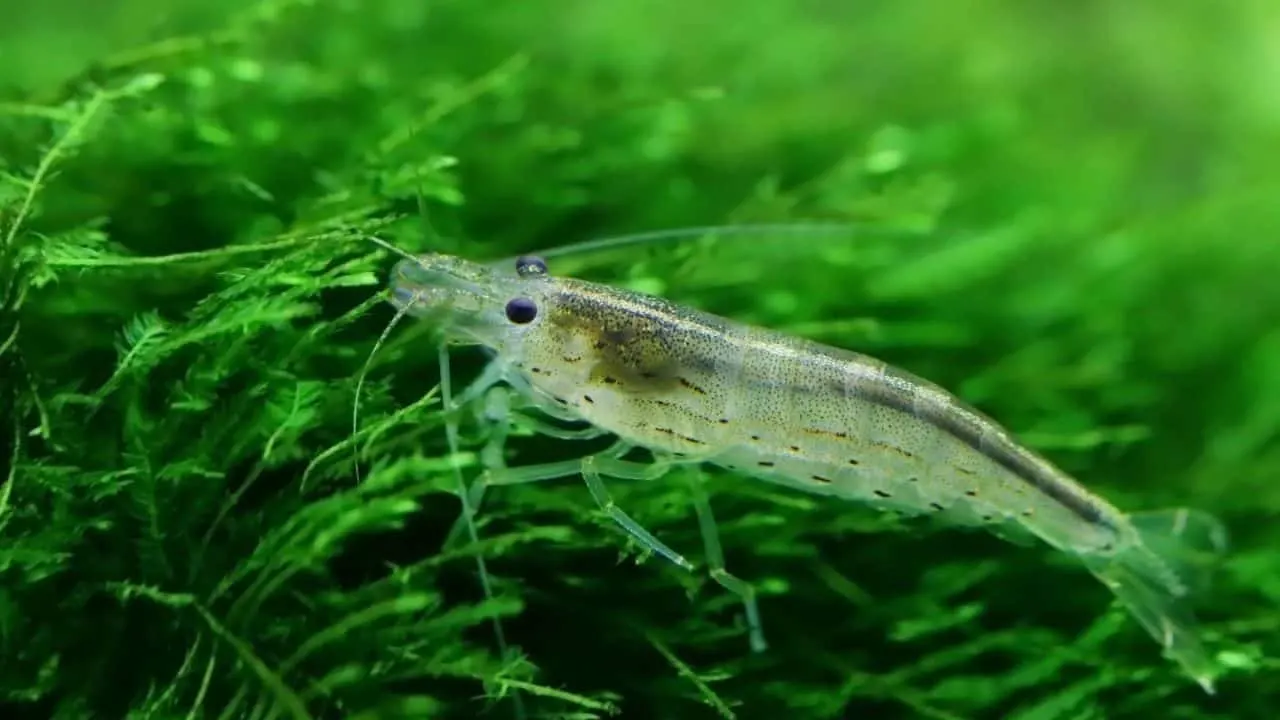
One of the best and most popular floating aquarium plants is Java Moss. It is an excellent plant whether you are experienced or inexperienced with aquatic planting.
It thrives in almost all conditions and can work with various tank mates, from fish to plants.
It is a prominent member of the Hypnaceae family from South Asia. Scientifically known as Taxiphyllum Barbieri, it has a medium growth rate and attains a height of about 4 inches (10 cm).
Java Moss’s other names include Mini Moss, Christmas Moss, and Willow Moss.
The Java Moss’s appearance has earned it good reviews and popularity. The reason being that it looks stunning no matter how you plan to grow it-floating, carpeting, etc.
This plant has no roots but consists of shoots and tiny oval leaves. Furthermore, it can be trimmed and shaped according to the grower’s preference without showing any signs of distress.
The only requirement this plant has is an anchor; you need to place it next to a supporting object, such as driftwood or a piece of cork.
A light object works better as it can float along with the plant.
Scientific name: Taxiphyllum Barbieri
- Common name: Java Moss
- Light requirements: low
- Nutrition: low
- Growth rate: moderate to fast
- Care: moderate
- Carbon dioxide supplementation: optional
Hornwort

Another top favorite of numerous aquatic plant growers is Hornwort. It arises from the Anthocerotophyta division, which has over 300 species.
They are usually 0.8 to 1.6 inches (2 to 4 cm) and are fond of damp soils and tropical climates.
Hornwort looks fantastic growing in water tanks due to its refreshing, delicate appearance. It colors the aquarium with a beautiful deep green shade that enhances all the other colors as well.
The leaves growing from thin stems have a wispy look that makes the Hornwort easy to recognize.
It grows pretty well with almost all types of floating plants, but it is better to research before introducing it into a fish tank. Overall, it is safe and grows well with most fish species.
The only thing you should carefully monitor its growth rate. It develops significantly faster, and if left untrimmed, it may block the nearby plants’ light.
Therefore, if you notice its leaves outgrowing their designated space, carefully prune the plant.
Failure to do so may result in clogging of filters and similar equipment, along with damage to neighboring plants.
- Scientific name: Ceratophyllum demersum
- Common name: Hornwort
- Light requirements: low
- Nutrition: low
- Growth rate: slow to moderate
- Care: easy
- Carbon dioxide supplementation: optional
Cabomba
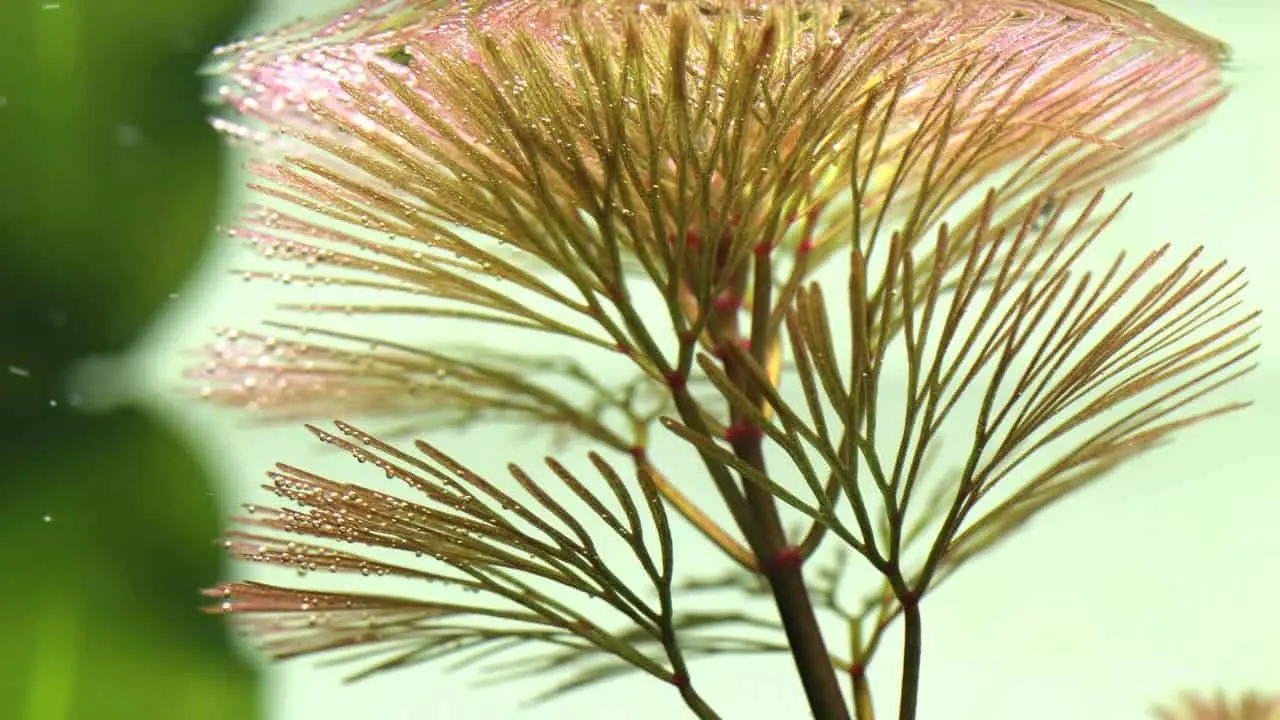
The Cabomba plant is another famous aquarium beauty. Scientifically known as Cabomba sp., it is grown worldwide due to its accommodating nature and characteristics.
When grown in high light levels combined with moderate feeding, the plant reaches a height of about 20 inches (50.8 cm).
Its unique look is what sets it apart from its fellow species. Although a weed, it has an attractive full appearance that makes it look like a lush, well-maintained plant.
Apart from good looks, the Cabomba plant is also easy to maintain. All you need to do is drop it in the aquarium; it will do the rest itself.
As mentioned earlier, its accommodating nature allows it to flourish in a wide variety of waters, provided it has sufficient light and feed.
Moreover, it works exceptionally well as a hiding place for fish that like to stay behind coverings. If you are also breeding critters, they will love it as much as the fish.
- Scientific name: Cabomba sp.
- Common name: Cabomba
- Light requirements: high
- Nutrition: moderate
- Growth rate: moderate
- Care: moderate
- Carbon dioxide supplements: optional
Duckweed
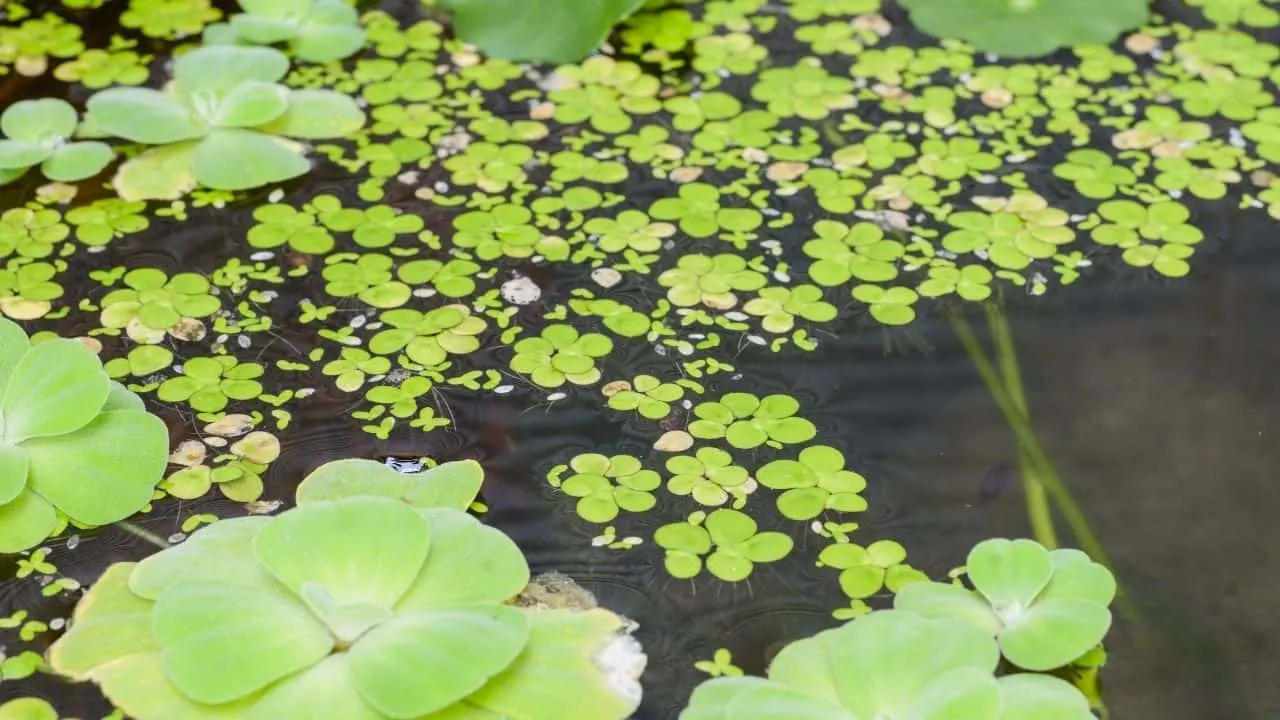
Duckweed, known by some botanists as Lemnaceae, is a family of monocotyledonous water plants with fast growth rates.
It has a very efficient reproductive system; therefore, it multiplies within days, sometimes even covering an entire water body surface.
The plant easily grows in several environments, making them look neat and green. The Duckweed plant has a flattened structure that either has roots on the underside or none at all.
Many aquatic plant growers initially enjoy the rapid growth rate; however, as time progresses, Duckweed begins covering close-by plants, causing major issues.
To prevent this problem, all you need to do is keep a close eye on this beauty and trim it as soon as you feel it is taking more than the necessary space.
If you are growing creatures that require a lot of sunlight perpetually, Duckweed may not be the best option.
However, if your aquatic friends enjoy the shade, Duckweed is the plant for you. However, do not forget to trim the plant periodically.
Overall, apart from the fast growth rate, the Duckweed plant is fun to grow and pretty easy to care for. To bring a breezy look to your tank, plant it right away.
- Scientific name: Lemnaceae
- Common name: Duckweed
- Light requirements: low to moderate
- Nutrition: low
- Growth rate: slow to moderate
- Care: low to moderate
- Carbon dioxide supplementation: optional
Red Root Floater
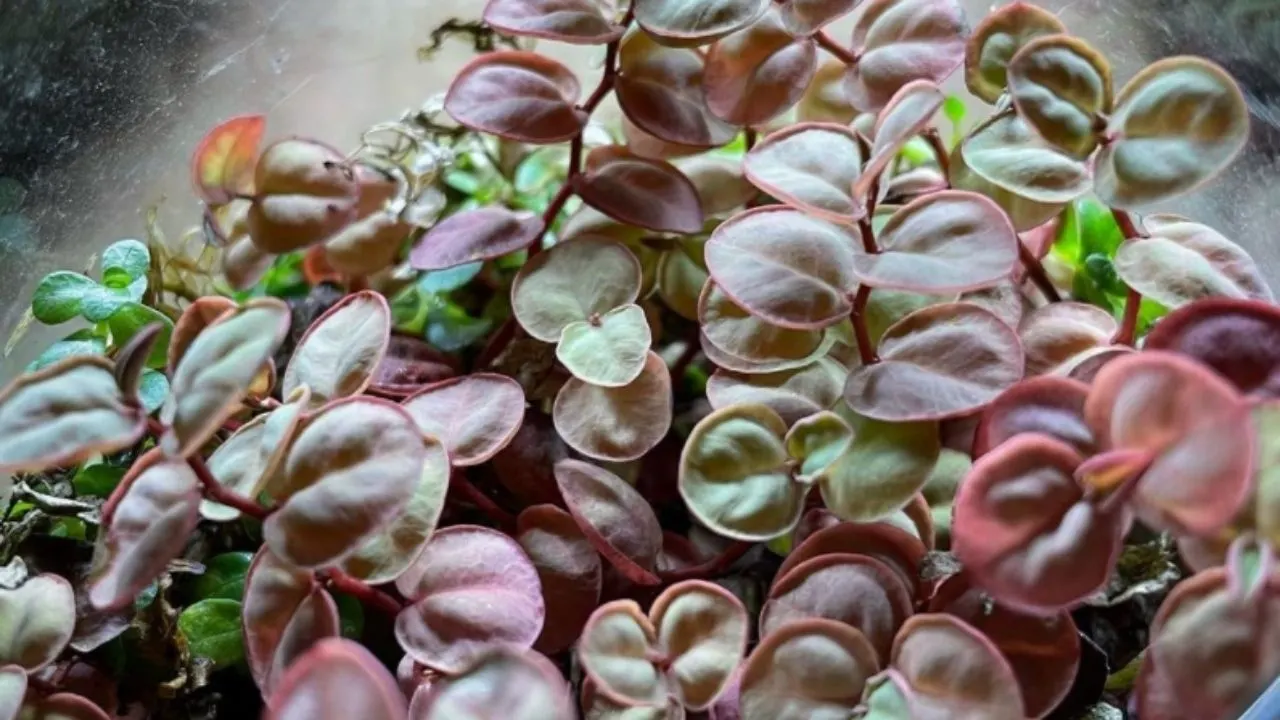
Photo Credit: @newmercieseverymorning on Instagram!
The Red Root Floater arises from South America and is associated with the Phyllanthus family. It thrives in several environments, which means you can grow it in just about all water types.
Moreover, the leaves grow to about 1 inch (2.5 cm) and may be colored green or red.
Its leaves may turn from green to red in the appropriate conditions.
The bottom part, along with the roots, normally has a great chunk of red in it, but the leaves turning red is what makes the Red Root Floater so fascinating.
Please remember not to deprive it of light completely, as then the plant forms yellow leaves, which completely bring down its appealing look.
If you want to have red leaves, keep the Red Root Floater in ample amounts of sunlight.
You can either place the water tank close to a tinted window or under artificial lights (lamp, bulb, etc.). For those who are fans of bold colors, the Red Root Floater is for you.
- Scientific name: Phyllanthus Fluitans
- Common name: Red Root Floater
- Light requirements: low to moderate
- Nutrition: low
- Growth rate: slow
- Care: easy
- Carbon dioxide supplementation: optional
Amazon Frogbit
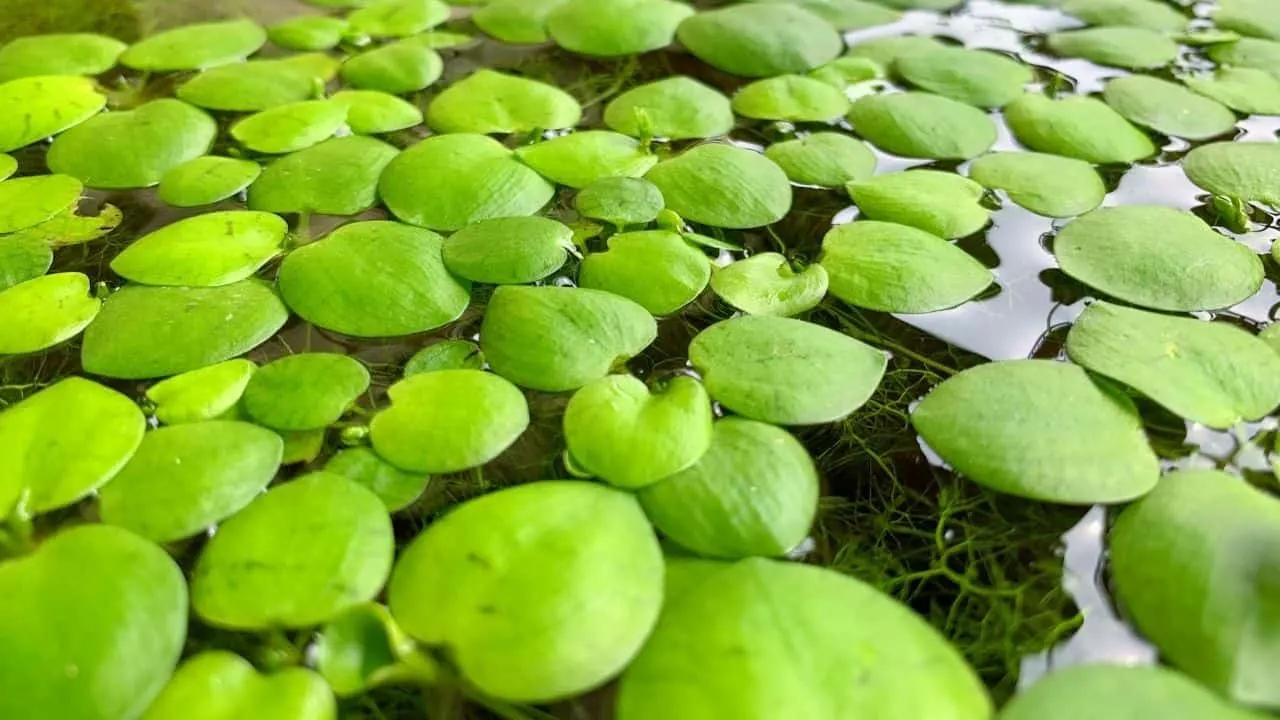
Another popular floating aquarium plant is the Amazon Frogbit. Scientifically known as Limnobium Laevigatum by some, the plant is a member of the Hydrocharitaceae family.
The Amazon Frogbit was introduced to North America through its use in aquascapes and aquariums.
Perhaps the plant’s most appealing feature is its mini lily-pad, decently sized and green in color. Due to this, Amazon Frogbit also performs excellently as an aquascaping plant.
Furthermore, the Amazon Frogbit plant has somewhat long roots that form mesmerizing effects in the water tank, especially if there is some current.
The plant’s sturdy and fairly flat leaves have similar effects.
With a generous range of water parameters, it flourishes well in all water types without much hassle.
Most importantly, you do not need to constantly keep an eye on it or trim it every few days, unlike several aquatic plants.
- Scientific name: Limnobium Laevigatum
- Common name: Amazon Frogit
- Light requirements: low
- Nutrition: low
- Growth rate: slow to moderate
- Care: easy
- Carbon dioxide supplementation: optional
Dwarf Water Lettuce
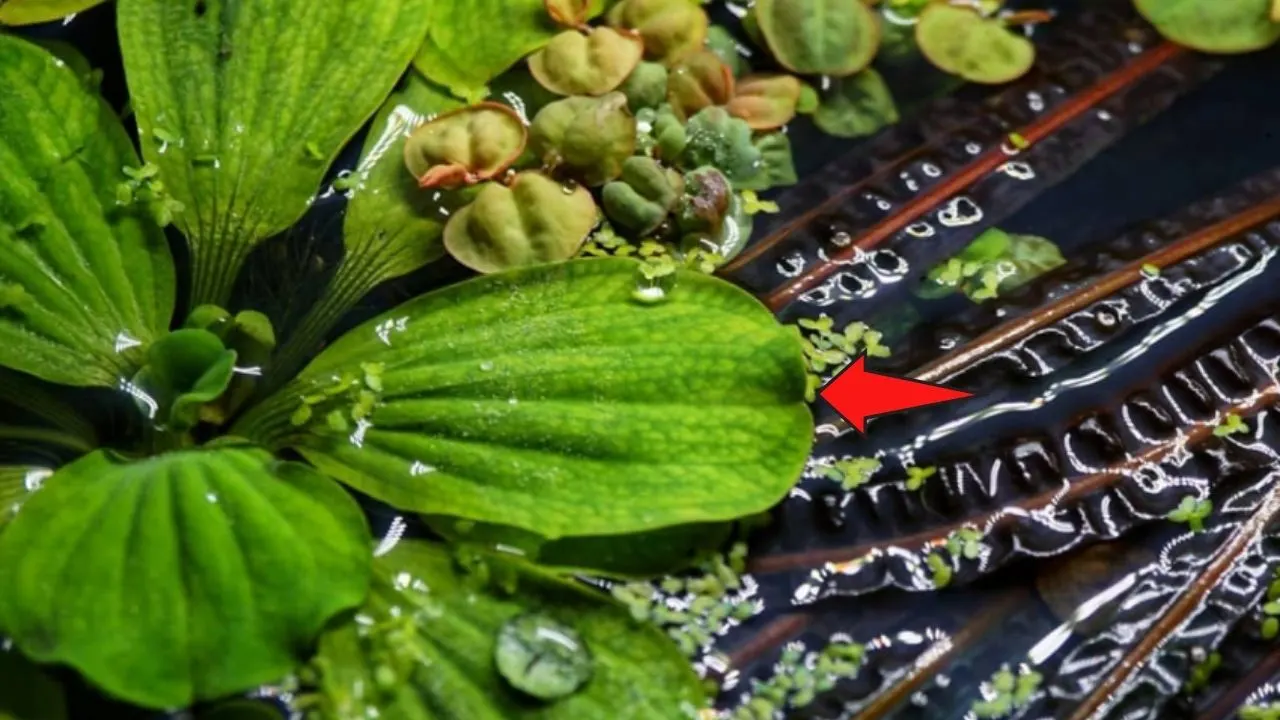
Photo Credit: @quickfreddie on Instagram!
Another beautiful aquarium floating plant is the Dwarf Water Lettuce.
Botanically known as Pistia stratiotes, it is an herbaceous perennial first discovered along the Nile River, hence the other name ‘Nile Plant.’ However, it is available all over the world now.
Due to its attractive looks, the Dwarf Water Lettuce plant has thousands of diehard fans that grow this beauty even before putting the fish in their water tank.
Once it attains maturity, it gives an aquarium a sophisticated yet natural look.
This plant looks like it is made just for aquariums. The only setback is that it has considerably large leaves that may shade surrounding plants, resulting in problems like algae and wilting.
However, do not fret because the Dwarf Water Lettuce is pretty easy to trim and maintain.
One thing to keep in mind is that Dwarf Water Lettuce likes growing in large water tanks only. Thus, unless your aquarium is 30 gallons or bigger, do not consider growing it.
- Scientific name: Pistia stratiotes
- Common name: Dwarf Water Lettuce
- Light requirements: low
- Nutrition: low
- Growth rate: low
- Care: moderate
- Carbon dioxide supplementation: optional
Brazilian Pennywort
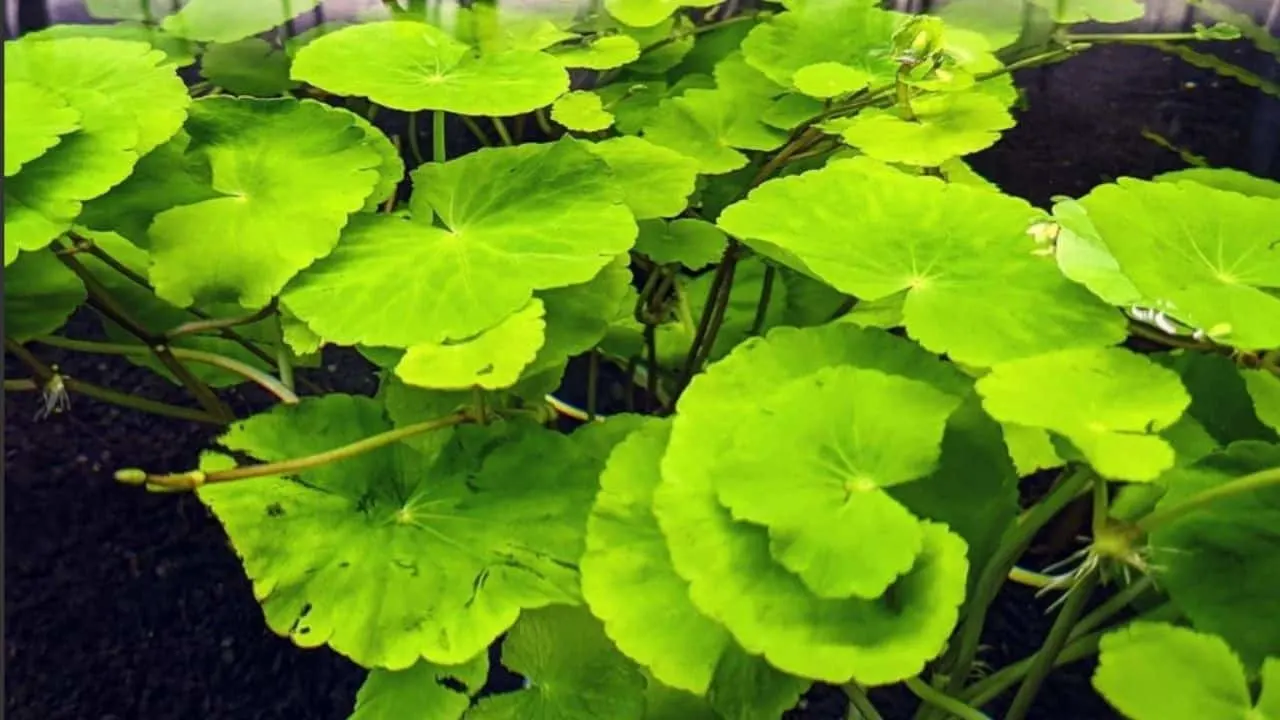
Photo Credit: @thereefindy on Instagram!
One of the neatest floating aquarium plants is the Brazilian Pennywort, a plant capable of completely changing your fish tank’s look.
Arising from the family of Apiaceae, the plant is native to South America. It has an undemanding nature, requiring low to medium light and moderate good-quality feed.
The Brazilian Pennywort grows so fast that it spreads to about 6 inches and attains a 24-inch height.
It has large, circular leaves that resemble lily-pads, each adequately spaced from one another. The leaf pattern also allows some light to pour into the tank while simultaneously creating a nice light pattern.
The growth rate is primarily dependent on the amount of light the Brazilian Pennywort receives; keep it in moderate light to keep the development in control.
Trim the plant occasionally for a neat look.
Under the proper care, the Brazilian Pennywort may even give you a pleasant surprise with its pretty flowers.
- Scientific name: Hydrocotyle leucocephala
- Common name: Brazilian Pennywort
- Light requirements: low
- Nutrition: low
- Growth rate: fast
- Care: moderate
- Carbon dioxide supplementation: optional
Water Wisteria

Photo Credit: @jonathanwotc on Instagram!
Another floating aquatic beauty is the Water Wisteria, is a part of the plant family Acanthaceae. The plant is naturally found in Pakistan, Bangladesh, India, and Nepal.
It grows well as a floating plant and a substrate-rooting plant.
The Water Wisteria has quite an aesthetic look; the colors are vibrant and fresh, making the tank look wonderful under the correct lighting.
The plant has a durable stem that gives rise to thin, long leaves. Water Wisteria’s stem makes a good hiding place for fish that like cover.
The Water Wisteria grows reasonably fast, one reason why growing it may cause you little trouble. When the plant begins taking excessive space, cut down the extra leaves with some scissors.
If your aquatic friends do not have trouble with low lighting, you can grow Water Wisteria without a second thought.
- Scientific name: Hygrophila difformis
- Common name: Water Wisteria
- Light requirements: low
- Nutrition: low
- Growth rate: moderate to fast
- Care: moderate
- Carbon dioxide supplementation: optional
Anacharis

One of the most approachable and environment-friendly plants is Anacharis.
Botanically known as Elodea canadensis, the Anacharis plant is a part of the Hydrocharitaceae family. Requiring little light and infrequent feeding, it grows to a height of 72 inches (182 cm) in a short time.
Moreover, it can handle a various water temperatures and fish species.
It keeps your water tank well-oxygenated; therefore, plant it only if the fish you have are compatible with it. The good thing is it also stays healthy even if fish nibble on it.
I highly encourage occasional trimming for the Anacharis plant.
- Scientific name: Elodea canadensis
- Common name: Anacharis
- Light requirements: low
- Nutrition: low
- Growth rate: low to moderate
- Care: easy
- Carbon dioxide supplementation: optional
Floating Aquarium Plants and their Benefits
Apart from being visually appealing, floating aquarium plants provide shade for fish that like low-lit or shaded areas.
They also act as water filters, clearing a significant amount of waste from the tank and removing excess nitrate levels.
Many fish enjoy having hiding spots; floating aquarium plants work fairly well for such animals. Additionally, they provide a great deal of security and comfort to such fish, leading to lesser stress levels.
Floating aquarium plants also make delicious snacks for the fish that love spending most of their time in the tank’s upper portion.
Several omnivorous fish prefer having vegetation from their habitat to fulfill their nutritional demands.
Assuming you are feeding them typical fish food, they can acquire additional vitamins from the floating plants.
However, while a few nibbles here and there cause no harm, do not let the fish consume the entire plant.
Another great benefit of floating aquarium plants is that most are very low maintenance since they take up much of their carbon dioxide and light from the surroundings.
This allows you to focus on fishkeeping instead of constantly worrying about upkeeping the floating plants.
- Visually appealing
- Provide shade for fish
- Act as water filters, clearing a significant amount of waste from the tank
- Remove excess nitrate levels
- Make delicious, nutritional snacks for fish
- Low maintenance
Conclusion
All plants listed here make great floating aquarium plants. With little care, you can grow and maintain them for years.
However, keep an eye on the growth rate and spread, as most require periodic trimming.
Lastly, only grow the floating aquarium plant that is compatible with your fish and other aquatic creatures.

Daniel has been a plant enthusiast for over 20 years. He owns hundreds of houseplants and prepares for the chili growing seasons yearly with great anticipation. His favorite plants are plant species in the Araceae family, such as Monstera, Philodendron, and Anthurium. He also loves gardening and is growing hot peppers, tomatoes, and many more vegetables.


